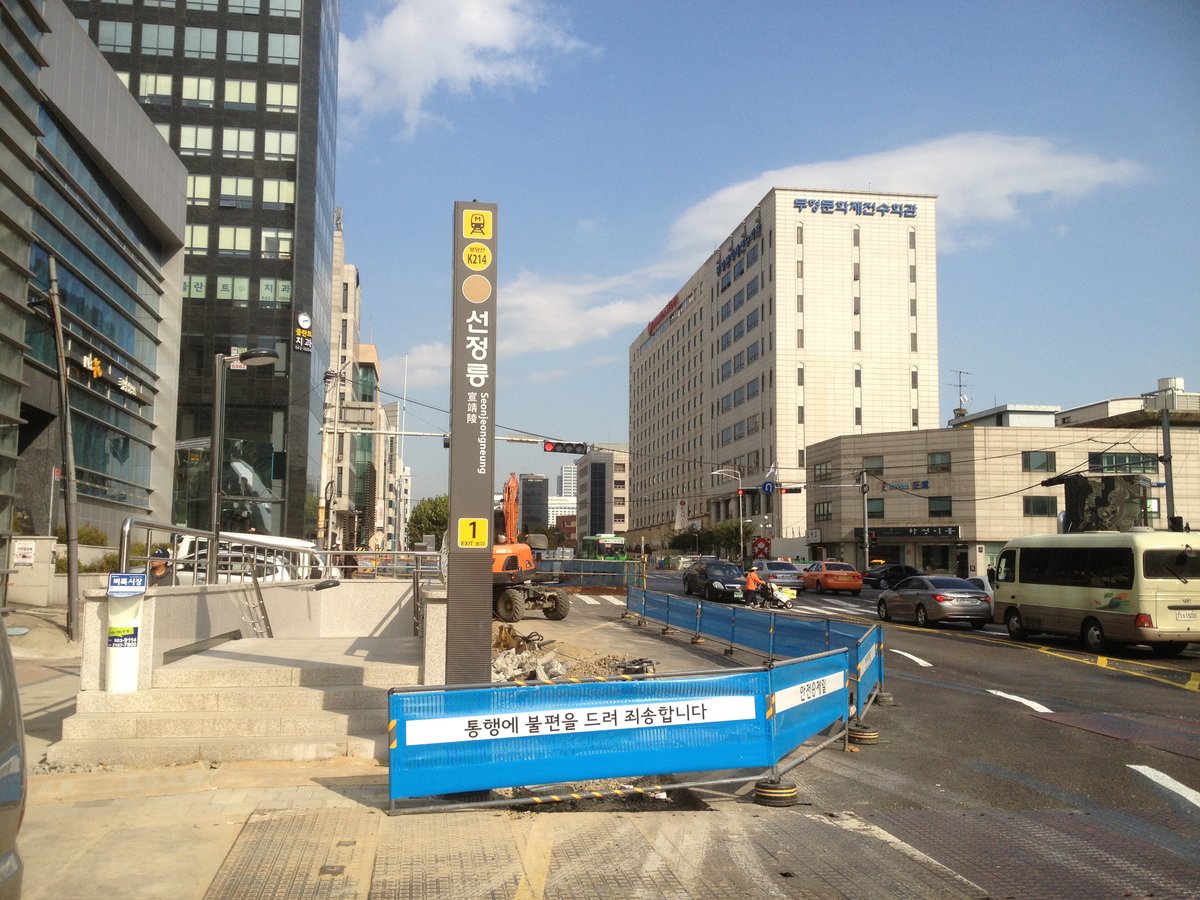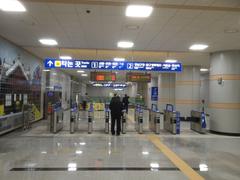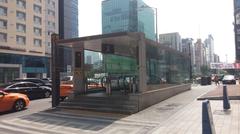
Seonjeongneung Station Visiting Hours, Tickets, and Seoul Historical Sites Guide
Date: 14/06/2025
Introduction to Seonjeongneung Station and Royal Tombs
Located in the heart of Seoul’s dynamic Gangnam district, Seonjeongneung Station serves as a vital gateway to the UNESCO World Heritage-listed Seonjeongneung Royal Tombs. This site is a tranquil oasis where visitors can experience the profound heritage of the Joseon Dynasty, marvel at traditional Korean architecture, and witness the ongoing practice of Confucian rituals, all set amid a backdrop of modern skyscrapers. With its convenient location on Seoul Subway Line 9 and the Bundang Line, Seonjeongneung is easily accessible for both locals and international travelers.
This comprehensive guide covers everything you need to plan your visit to Seonjeongneung: its historical background, visiting hours, ticketing details, accessibility features, station layout, and nearby attractions. For official and up-to-date information, visit Visit Korea and UNESCO Royal Tombs.
Table of Contents
- Introduction
- Historical Background and Significance
- Cultural and Architectural Features
- UNESCO World Heritage Status
- Visiting Seonjeongneung: Hours and Tickets
- Station Layout, Accessibility, and Transportation
- Visitor Etiquette and Tips
- Highlights and Seasonal Attractions
- Cultural Experiences and Special Events
- Nearby Attractions and Suggested Itineraries
- Practical Information for Visitors
- Frequently Asked Questions (FAQ)
- Conclusion
- References and Further Reading
Historical Background and Significance
Seonjeongneung Royal Tombs comprise two main tomb areas: Seolleung (tombs of King Seongjong and Queen Jeonghyeon) and Jeongneung (tomb of King Jungjong). These tombs commemorate pivotal figures of the Joseon Dynasty (1392–1897), a period that shaped Korea’s Confucian traditions and legal codes.
- King Seongjong (1457–1494): The ninth monarch, recognized for consolidating Confucian governance and codifying state laws.
- Queen Jeonghyeon (1462–1530): Third wife of Seongjong, renowned for her influence on royal lineage and religious patronage.
- King Jungjong (1487–1544): The 11th monarch, remembered for his reforms and the political turbulence of his reign.
The tombs reflect the Joseon Dynasty’s emphasis on ancestral reverence, geomantic principles, and harmony with nature (Wikipedia: Seonjeongneung).
Cultural and Architectural Features
Confucian Rituals and Symbolism
Seonjeongneung is an active site for traditional Confucian ancestral rites (Jesa), which underscore the values of filial piety and continuity. The tombs’ layouts include ceremonial halls, spirit roads, and guardian statues, all designed to protect and honor the royal spirits.
Architectural Highlights
- Stone Statues: Civil and military official figures, horses, and sheep flanking the burial mounds.
- T-shaped Shrines (Jeongjagak): Venues for memorial ceremonies.
- Red-spiked Gates (Hongsalmun): Signify entry into sacred space.
- Natural Harmony: The tombs are nestled among ancient pine forests, blending architecture with the landscape.
UNESCO World Heritage Status
Recognized as part of the “Royal Tombs of the Joseon Dynasty,” Seonjeongneung exemplifies both architectural excellence and the spiritual traditions of Korea’s past. Conservation efforts prioritize the preservation of original materials and the integrity of ritual spaces (UNESCO Royal Tombs).
Visiting Seonjeongneung: Hours and Tickets
Royal Tombs Visiting Hours
- February – October: 6:00 a.m. – 8:00 p.m. (last admission 7:00 p.m.)
- November – January: 6:30 a.m. – 5:30 p.m. (last admission 5:00 p.m.)
- Closed: Mondays
Admission Fees
- Adults: 1,000 KRW
- Youth (7–18): 500 KRW
- Children under 6/Seniors over 65: Free
- Culture Day: Last Wednesday of every month, free admission
Tickets can be purchased onsite or online via Klook and Visit Korea. Guided tours and audio guides are available; booking in advance is recommended during peak seasons.
Station Layout, Accessibility, and Transportation
Station Overview
Seonjeongneung Station is an interchange on Seoul Subway Line 9 and the Suin–Bundang Line. The station is modern, with clear multilingual signage, elevators, escalators, and accessible restrooms. Ticket machines accept cash and cards, and Tmoney card recharge kiosks are readily available.
Exits
- Exit 1: Closest to the Royal Tombs’ main entrance.
- Other Exits: Access to business and residential areas, local amenities.
Accessibility
- Wheelchair Access: Elevators, ramps, and tactile paving are provided.
- Restrooms: Accessible facilities with emergency features.
- Luggage Lockers: Available near the tombs’ entrance (teretoadescubrirelmundo.com).
Transportation Options
- Subway: Operating from approximately 5:30 a.m. to midnight.
- Bus: Multiple routes serve the area; Tmoney card accepted.
- Taxi: Metered taxis and international taxi services are available.
- Walking/Cycling: Pedestrian-friendly with bike rental options.
- Airport Access: Direct via Line 9 from Gimpo Airport; from Incheon Airport via AREX and transfer (Korea Tourism Organization).
Visitor Etiquette and Tips
- Remain respectful and quiet; do not climb on tomb mounds or statues.
- Photography is allowed, except in restricted areas. Drones and commercial filming require permission.
- Modest attire is recommended.
- Wear comfortable shoes for uneven terrain.
- Check weather in advance; Seoul summers are hot and winters cold.
- Early morning or late afternoon visits offer fewer crowds and pleasant temperatures.
- Most signage is bilingual; staff can provide assistance.
Highlights and Seasonal Attractions
- Seolleung (King Seongjong & Queen Jeonghyeon): Double mound, elaborate statues, serene pine forest.
- Jeongneung (King Jungjong): Quiet, austere, surrounded by ancient trees.
- Seasonal Beauty: Cherry blossoms in spring, vibrant foliage in autumn.
- Cultural Events: Ancestral rites (Jesa) in spring and autumn; check for music festivals and art exhibitions nearby (Korea Cultural Heritage Administration; allevents.in).
Nearby Attractions and Suggested Itineraries
- COEX Mall and Aquarium: Shopping, dining, and entertainment (COEX Aquarium).
- Bongeunsa Temple: Buddhist temple with cultural programs.
- Gangnam District: Trendy shops, K-pop culture, nightlife.
- Samseong-dong and Teheran-ro: Business hubs, art galleries, international cuisine.
- Cheonggyecheon Stream: Urban restoration project for scenic walks (koreatravelplanning.com).
- Bukchon Hanok Village: Traditional Korean houses (koreatravelplanning.com).
- Namsan Seoul Tower: Panoramic city views (koreatravelplanning.com).
A typical Seonjeongneung visit lasts 1–2 hours, and can be combined with other sites for a full day in Gangnam.
Practical Information for Visitors
- Language: Korean and English signage throughout.
- Payments: Cash (KRW), credit cards, and Tmoney card accepted.
- Safety: Area is secure and well-monitored.
- Dining: Numerous nearby restaurants and cafes; local specialties include bibimbap and bulgogi.
Frequently Asked Questions (FAQ)
Q: What are the Seonjeongneung visiting hours?
A: February–October: 6:00 a.m.–8:00 p.m.; November–January: 6:30 a.m.–5:30 p.m.; closed Mondays.
Q: How much is the entrance ticket?
A: 1,000 KRW for adults; discounted/free for youth, children, and seniors.
Q: Are the tombs accessible for wheelchair users?
A: Main paths are wheelchair accessible; some areas may have uneven terrain.
Q: Are guided tours available?
A: Yes, in English and Korean. Audio guides and brochures are also offered.
Q: Can I take photographs?
A: Photography is allowed, except in restricted areas or with drones/tripods.
Q: What’s the best time to visit?
A: Early morning or late afternoon, especially in spring or autumn.
Conclusion
Seonjeongneung Royal Tombs provide a unique opportunity to explore Korea’s rich royal history, Confucian traditions, and natural beauty—all conveniently accessible from Seonjeongneung Station in Gangnam. Whether you seek cultural immersion, architectural appreciation, or a peaceful retreat, Seonjeongneung is a must-visit destination in Seoul. Enhance your experience by checking for guided tours, special events, and nearby attractions. For more insights and updates, consult official resources and consider downloading the Audiala app for onsite audio guides and travel tips.
Embark on a journey through Korea’s royal legacy—where history, culture, and nature converge in the heart of Seoul.
References and Further Reading
- Seonjeongneung Visiting Hours, Tickets, and Guide to Seoul’s Royal Tombs, 2024, Visit Korea (Visit Korea)
- Seonjeongneung Royal Tombs Visiting Hours, Tickets, and Guide to Seoul’s UNESCO World Heritage Site, 2024, UNESCO & Korea Tourism Organization (UNESCO Royal Tombs)
- Seonjeongneung Station Visiting Guide: Layout, Accessibility, Tickets, and Nearby Seoul Historical Sites, 2024, Seoul Metropolitan Government (Visit Seoul)
- Visiting Seonjeongneung Royal Tombs: Tickets, Hours, and Guide to Seoul’s Historical Site, 2024, Teretoadescubrirelmundo & Klook (Klook)
- Seoul Unexpected Blog
- inmykorea.com
- allevents.in
- COEX Aquarium
- koreatravelplanning.com














































































































































































































